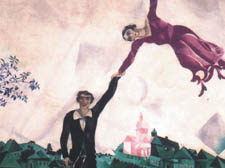|
|
 |
| |

Promenade by Marc Chagall, |
Children find Russian Revolution A dozen primary schoolchildren sat on the floor of the Royal Academy. “You help to keep the place clean,” joked their mentor, dwarfed by the huge Matisse masterpiece, Dance II, 1910, that has become the icon of the crowd-pulling From Russia exhibition.
Their uncluttered minds fixed on the pure energy of the red-brick figures flying over their heads in a primitive gyration of power and joy. They were full of innocent comment about the painting, as if they could feel the unheard beat of the music that even told them the direction of the dancers above their heads. Not for them the political row that went on between Britain and Russia that almost banned the exhibition from Piccadilly.
They could now be stimulated by masterpieces by Matisse, Monet, Cezanne, Gauguin, Picasso and Rousseau that have been jealously hidden from the west for decades. And ironically so by a country that crudely stifled creativity following the 1917 revolution, when abstract art was not only regarded as politically incorrect but virtually crushed and banned.
It was thanks to Sergei Shchukin and Ivan Morozov, two Russian textile merchants who bought and commissioned works by the progressive French artists of the early 19th century, that they arrived in Russia in the first place.
They ended up with 37 works by Matisse, 50 by Picasso, 16 Gauguins, four van Goghs and a roomful of Cezannes decorating their Moscow mansion. The art itself changed the face of Russian painting that went on to give us Kandinsky and the constructivist Tatlin.
It is a joy to encounter such talent, an opportunity to indulge in the wonder of Monet’s magnificently moving red Poppy Field, Matisse’s The Red Room, where the scarlet wallpaper invades the canvas, and the simpler enchantment of Derain’s Drying the Sails, a harmonious harbour scene of beached boats.
But what of the less recognisable art of the gifted Russians who experimented with cubism and fauvism? Some certainly grab your attention, in particular the blue, yellow and green portrait of the poet Anna Akhmatova by Natay Altman; the portrait of Sergei Diaghilev with his nanny in the gloomy background by Leon Bakst; Boris Kustodiev’s Rubenesque blonde nude smilingly called Beauty, and Chagall’s grand aerial avant garde Promenade.
It is, hopefully, art that builds bridges of recognition and enjoyment epitomised by the young children who sat before Matisse’s masterpiece knowing nothing of the hate of history.
GERALD ISAAMAN
|

|
 |
|
 |
|

